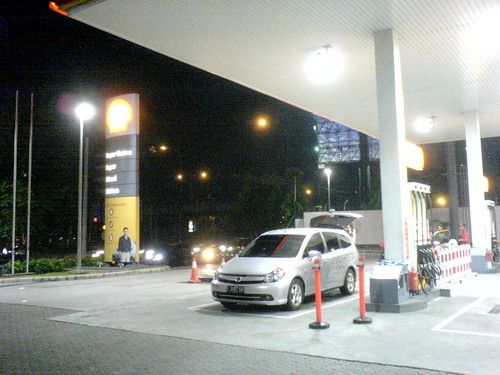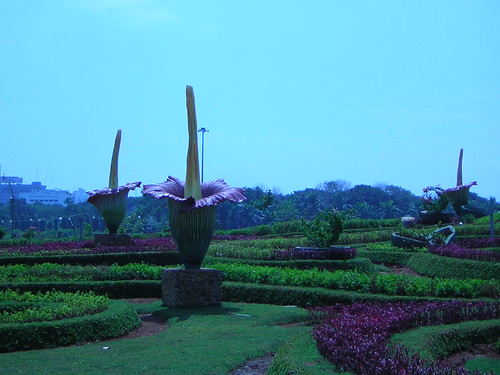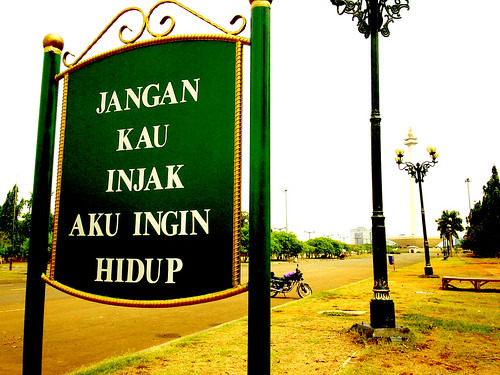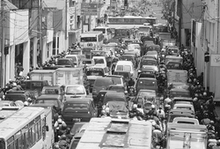Decreasing Green Areas in Jakarta

New Style Gas Station, originally uploaded by cyberlucky.
In 1965, the green areas made up more than 35 percent of the Jakarta's area and have been shrinking since then. Currently, the green areas in Jakarta account for only 9.3 percent of the area and it is far below the target of 30 percent set by the central government.
Decreasing green areas in Jakarta must be turned around. Green areas are an important urban element that make urban spaces more sustainable and livable. The annual floodings in Jakarta strongly indicate the urgency of green areas in Jakarta. More green areas are needed in Jakarta to absorb rainwater and eventually avert floodings.
Jakarta as the Indonesia's primary growth machine is poised to grow and expand its urban areas. The proportions of green areas in the Jakarta spatial plans decrease from 27.6 percent in the Jakarta spatial plan 1965-1985 to 13.94 percent in the current Jakarta spatial plan 2000-2010. New homes, condominiums, malls, hotels, commercials and office buildings have proliferated in Jakarta in the last three decades. Those new developments converted green areas, decreased water catchment areas and made urban areas more prone to floods.
The conversion of green areas in Jakarta is also the direct impact of poverty and unemployment. Despite a robust economic growth, Jakarta is still a place of poverty and unemployment. Many urban poor resort to living on the banks of rivers. The presence of squatters along the river banks decreases green areas and makes areas more vulnerable to floods.
Due to limited employment opportunities in the formal sector, most people with few skills and little education will end up in the informal sector as they attempt to make a living. Urban spaces for the informal sectors in Jakarta are very limited and it leads the informal sectors to occupy many green areas including city parks.
The expansion of green areas in Jakarta is quite a challenge for the city administration because of the growing demand for urban areas to accomodate the economic growth and the presence of squatters and the informal sectors. Nonetheless, the decision of the city council to reject the plan of relocating 29 gas stations should be regretted. The city should not set aside the need of green areas over the importance of gas stations for meeting the needs of the growing number of motorized vehicles.
Not only will the decision halt the expansion of green areas but also promote the use of more motorized vehicles that will increase the carbon dioxide emissions resulted from the burning of vehicle fuels. The decision averts more green areas which are supposed to reabsorb the emission of carbon dioxide from the vehicles. The conversion of gas stations to green areas would also discourage more people to use private vehicles because the location of gas stations are no longer convenient for them. Eventually, more people would shift to public transportation.
The decision by the city council also reflects the unfairness towards poor people and the informal sector. There have been many cases of evictions of urban poor and the informal sectors for the sake of green areas in Jakarta, for example the eviction of the fish and flower traders in Jl. Barito in January 2008 to expand the Ayodia Park. It clearly indicates that the expansion of green areas is more easily implemented through the evictions of poor people and the informal sector than the relocation of gas stations or other formal sector activities.
The expansion of green areas must be implemented to any land uses that are not in compliance with the Jakarta spatial plan. The expansion should not only aim the informal sectors and squatters on the river banks but also any formal sectors that occupy areas designated as green areas in the Jakarta spatial plan including the gas stations. Therefore, the decision made by the Jakarta city council not to relocate gas stations should be revisited.
(This article also appeared at The Jakarta Post on March 17, 2008)






2 comments:
Halo pa deden, pa kabar? posting green issue ini cukup inspiratif, ternyata (tentunya) jauh lbh kompleks dr skdr isu lingkungan. Btw join milis plitbabroad yuk (http://groups.yahoo.com/group/Plitbabroad atau http://plitbabroad.blogspot.com), mudah2an bs mempererat jaringan & sumbangsih alumni PL yg sedang di luar negeri.
Formerly beautiful kampungs, which had lovely gardens and orchards, are disappearing to make way for golf courses, luxury houses, ugly shopping malls and ugly factories. The rich are separated from the poor by a growing number of high walls, just like in Israel-Palestine.
Post a Comment